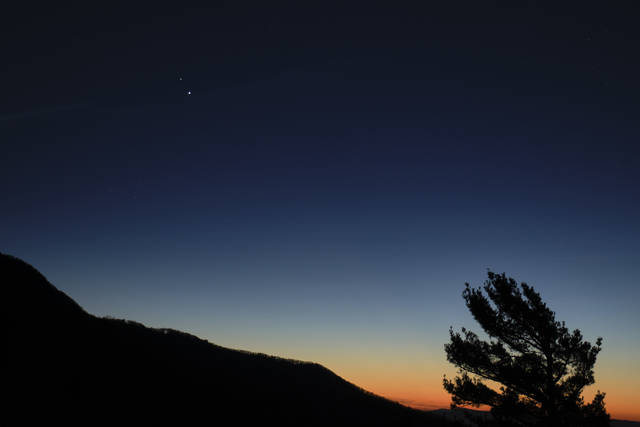Clouds will likely block view of 'Christmas Star' tonight; won't be visible again until 2080
The planets Jupiter and Saturn will be so close to one another tonight that they will look like a single bright point of light in the sky — a phenomenon that some refer to as the “Christmas Star” or “Star of Bethlehem.”
But viewers in the Pittsburgh region and most of the eastern seaboard likely will only see clouds, drizzle and snow flurries when their gaze turns to the heavens the evening of Dec. 21.
“I doubt people will be able to see anything, but there is a small chance of getting a brief peek if there’s a break in the cloud cover,” said Lee Hendricks, a meteorologist with the National Weather Service in Moon. “It’s something that won’t happen again in our lifetimes, but sadly there’s no place close to Pittsburgh where the skies will be clear enough to see it.”
If there is a break in the clouds, the best time to view the conjunction of planets will be at at twilight between 5:30 and 6:30 p.m. looking southwest. Dec. 21 also marks the winter solstice, which is the day of the year with the shortest period of daylight and longest night.
Hendricks said the closest places to Pittsburgh that will afford a clear view of the two planets meeting up is likely to be in western Ohio and eastern Indiana.
Jupiter takes 12 years to travel around the sun, according to Mike Hennessy, manager of the Carnegie Science Center’s Buhl Planetarium on Pittsburgh’s North Shore. It takes Saturn 30 year to make the trip, he said.
But every 20 years a “conjunction” occurs when they pass each other during their trek around the sun, making the two planets appear as a single, bright object in the celestial sky even though they are 403 million miles apart, he said.
The two planets haven’t been this close to each other since the spectacular astral event that hasn’t occurred since the Middle Ages, making this year’s event a “great conjunction,” Hennessy said.
He said a simple way to envision what is occurring is to think of two track runners, with Jupiter on the inside track around the sun and Saturn on the outside track.
The conjunction occurs when the two runners pass each other on the track and are “neck and neck,” he said.
The conjunction will put out as much light as one-fifth of the diameter of the full moon in the night sky, Hennessy said.
Lou Coban, of the University of Pittsburgh’s Allegheny Observatory, said the next great conjunction isn’t expected to happen again until 2080.
He said if the sky is clear enough, a viewer could spot the rings of Saturn by with a a pair of binoculars or a modest telescope, which will show the two largest planets in the solar system in the same field of vision.
Tony LaRussa is a TribLive reporter. A Pittsburgh native, he covers crime and courts in the Alle-Kiski Valley. He can be reached at tlarussa@triblive.com.
Remove the ads from your TribLIVE reading experience but still support the journalists who create the content with TribLIVE Ad-Free.

